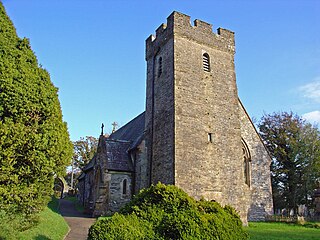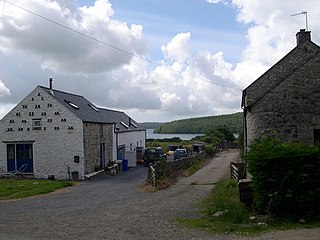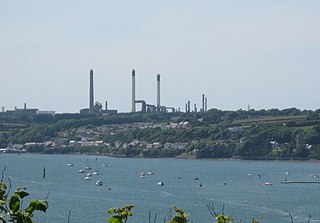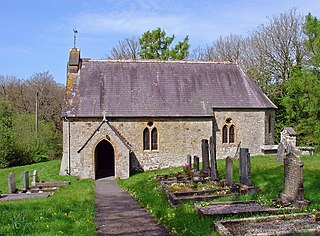
Pembrokeshire is a county in the south-west of Wales. It is bordered by Carmarthenshire to the east, Ceredigion to the northeast, and the rest by sea. The county is home to Pembrokeshire Coast National Park. The Park occupies more than a third of the area of the county and includes the Preseli Hills in the north as well as the 190-mile (310 km) Pembrokeshire Coast Path.

Pembroke is both a town and a community in Pembrokeshire, Wales, with a population of 7,552. The names of both the town and the county have a common origin; both are derived from the Cantref of Penfro: Pen, "head" or "end", and bro, "region", "country", "land", which has been interpreted to mean either "Land's End" or "headland".

Chevron Corporation is an American multinational energy corporation. The second-largest direct descendant of Standard Oil, and originally known as the Standard Oil Company of California, it is headquartered in San Ramon, California, and active in more than 180 countries. Chevron is engaged in every aspect of the oil and natural gas industries, including hydrocarbon exploration and production; refining, marketing and transport; chemicals manufacturing and sales; and power generation.

Valero Energy Corporation is a Fortune 500 international manufacturer and marketer of transportation fuels, other petrochemical products, and power. It is headquartered in San Antonio, Texas, United States. Throughout the United States and Canada, the company owns and operates 15 refineries, and one in Wales, with a combined throughput capacity of approximately 3 million barrels (480,000 m3) per day, 11 ethanol plants with a combined production capacity of 1.2 billion US gallons (4,500,000 m3) per year, and a 50-megawatt wind farm. Before the 2013 spinoff of CST Brands, Valero was one of the United States' largest retail operators with approximately 6,800 retail and branded wholesale outlets in the United States, Canada, United Kingdom, and the Caribbean under the Valero, Diamond Shamrock, Shamrock, Beacon, and Texaco brands.

Milford Haven is both a town and a community in Pembrokeshire, Wales. It is situated on the north side of the Milford Haven Waterway, an estuary forming a natural harbour that has been used as a port since the Middle Ages. The town was founded in 1790 by Sir William Hamilton, who designed a grid pattern. It was originally intended to be a whaling centre, though by 1800 it was developing as a Royal Navy dockyard which it remained until the dockyard was transferred to Pembroke in 1814. It then became a commercial dock, with the focus moving in the 1960s, after the construction of an oil refinery built by Esso, to logistics for fuel oil and liquid gas. By 2010, the town's port had become the fourth largest in the United Kingdom in terms of tonnage, and continues its important role in the United Kingdom's energy sector with several oil refineries and one of the biggest LNG terminals in the world.

Maiden Wells is a small village located 1.6 miles (2.6 km) south of Pembroke in Pembrokeshire, Wales. The earliest reference to Maiden Wells is 'Mayden Welle' in 1336. The population is currently around 300.

Carew is a village, parish and community on an inlet of Milford Haven in the former Hundred of Narberth, Pembrokeshire, West Wales, 4 miles (6.4 km) east of Pembroke. The eastern part of the parish is in the Pembrokeshire Coast National Park.

The Delaware City Refinery, currently owned by Delaware City Refining Corporation, a subsidiary of PBF Energy, is an oil refinery in Delaware City, Delaware. When operational it has a total throughput capacity of 210,000 barrels per day (33,000 m3/d), and employs around 570 individuals.
Rosemarket is a village, parish and community in Pembrokeshire, Wales, north of Milford Haven.
Castlemartin is a village and parish in the community of Stackpole and Castlemartin, Pembrokeshire, Wales, in the Pembrokeshire Coast National Park.

Clydau is a community and parish in Pembrokeshire, Wales.

Bayvil is a hamlet and parish in Pembrokeshire, Wales. It is situated in the north of the county, 5 kilometres (3.1 mi) east of Newport. It is in the Pembrokeshire Coast National Park. The parish includes most of the village of Felindre Farchog. Together with the parishes of Monington, Moylgrove and most of Nevern, it constitutes the community of Nevern.

Coedcanlas is a small parish in Pembrokeshire, Wales, on the eastern shore of the Daugleddau estuary, 5 miles (8.0 km) north of Pembroke, in the Pembrokeshire Coast National Park. Together with the parishes of Martletwy, Minwear, Newton North and Lawrenny, it constitutes the community of Martletwy.

Cosheston is a village, parish and community in Pembrokeshire, Wales. It is situated on an inlet of the Daugleddau estuary, 3 km north-east of Pembroke. The parish includes the settlement of Bateman's Hill. The northern part of the community is in the Pembrokeshire Coast National Park. Together with Upton and Nash, it constitutes the community of Cosheston, which had a population of 713 in 2001, increasing to 828 at the 2011 Census.

The Pembroke Refinery is an oil refinery situated on the Pembrokeshire coast in Wales at Rhoscrowther in the community of Angle. It first came on stream in 1964 and was Regent/Texaco's only British refinery. The refinery occupies a prominent position on the south bank of the Milford Haven Waterway and can be seen for many miles. Around a quarter of the site is within the Pembrokeshire Coast National Park which was created in 1952.

The Gulf Refinery at Milford Haven was an oil refinery situated on the Pembrokeshire coast in Wales. The refinery, originally owned by Gulf Oil, was opened in August 1968 by Queen Elizabeth II. The plant, constructed at a cost of approximately £35 million, produced a range of petroleum products and occupied an area of 300 acres. Up to 119,000 barrels (18,900 m3) of oil could be processed a day at the facility.

Milford Haven Refinery was an oil refinery situated on the Pembrokeshire coast in Wales, United Kingdom. The refinery began operating in 1973 under Amoco's ownership, but in its final days it was owned by Murco Petroleum. The closure of the refinery was announced in November 2014. The site was sold to Puma Energy in 2015 for use as a petroleum storage and distribution terminal.

Meline is a parish in the Diocese of St David's in north Pembrokeshire, Wales. There is no settlement of this name.

Hodgeston is a small village and parish a mile southeast of Lamphey, south Pembrokeshire, Wales, and is in the community of Lamphey. It is on the A4139 Pembroke Dock to Tenby road. Other surrounding villages are Freshwater East, Jameston and Manorbier Newton.

St Decuman's is a Grade I listed building in Rhoscrowther, Pembrokeshire, Wales.



















